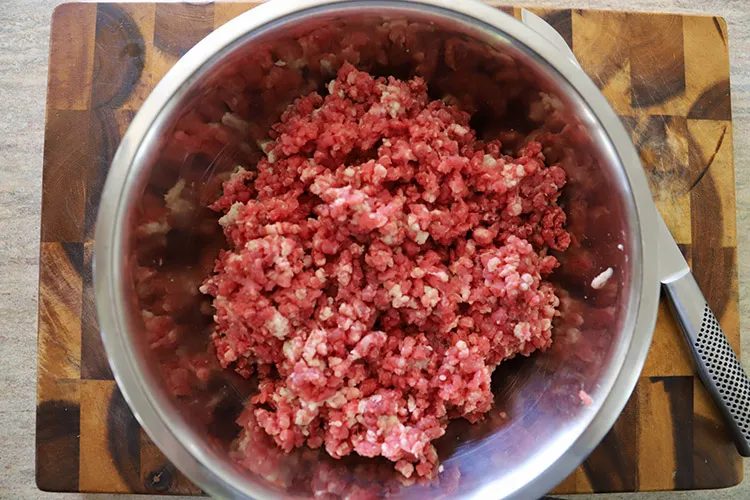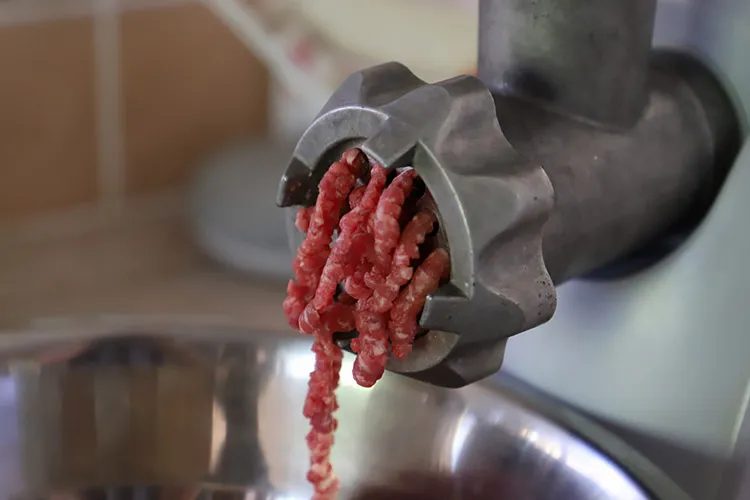There are endless ways to grill and top a burger, but one common denominator is they all need to be cooked to the appropriate temperature for food safety.
We’ll walk you through our burger temperature guide, how to stay safe when using ground meat, and our favorite method for grilling the perfect burger. Let’s dive in.
Grilled hamburger temperature guide
First and foremost, the USDA mandates that any pre-ground meat must be cooked to an internal temperature of 160°F. This ensures any lingering bacteria are killed and the meat is safe to eat.
For ground poultry, you’ll need to hit a temperature of 165°F to be considered safe.
So, why can steaks be eaten at a medium-rare 130°F then? It has to do with the actual behavior of bacteria itself.
Bacteria on a steak or whole piece of meat lives on the surface but doesn’t migrate elsewhere or burrow into the meat. Therefore, when a steak is seared at high temperatures, all the surface bacteria are killed.
The medium rare inside is safe because there are no bacteria internally.
However, if you are doubting the freshness of your steak even before cooking it, there are several telltale signs to look out for to distinguish a save-to-eat a piece of meat from a spoiled one.
Now, if you take that same steak and grind it up, the bacteria mixes throughout the meat, both inside and outside of the burger patty.

This is why the temperature of ground meat must hit 160°F in the middle. It ensures that the bacteria that was distributed in the grinding process has been killed and the meat is safe to eat.
For the most accurate temperature control, get a reliable meat instant read thermometer like the Thermapen MK4 and take readings in the thickest part of the meat.
Doing so will ensure the food stays within the temperature safety zone. Make sure the thermometer is cleaned and sanitized between each use.
What are the risks with ground beef?
Ground beef is much more susceptible to contamination than whole cuts for a number of reasons.
Pre-ground beef can be processed from multiple cows, unless otherwise stated on the packaging as being single-sourced. If multiple cows are processed into one final product, even 1% of tainted meat will contaminate the whole batch.
This grinding and processing distributes the bacteria throughout the meat being packaged and sent to market both commercially and directly to consumers. When this happens, grocery stores and restaurants alike are susceptible to serving bad meat.
USDA and cooking temperature guidelines
Some chefs see the USDA guidelines as too stringent, but they are put in place for public safety against widespread foodborne illness and disease. Restaurants and chefs work alongside the USDA and their local health departments to adhere to these guidelines and address any one-off instances – such as fermentation.
To serve a menu item the USDA may deem as high risk, a restaurant must create and implement a HAACP plan. HACCP stands for Hazard Analysis and Critical Control Point and is an internationally recognized system for mitigating and controlling the risk of food safety hazards.
Let’s say a chef wants to serve a burger at medium rare – an internal temperature of 130°F. They must first cooperate with their health department and agree on a HAACP plan to reduce the risk of illness.
For this specific issue to get the go-ahead, the plan would need to state that only meat ground in-house can be cooked and served medium rare. Any pre-ground meat would need to still be cooked to 160°F to be safe.
Reducing the risk of contamination
There are some simple steps we can all take to reduce the risk of contamination when preparing burgers. Follow the tips below:
- Keep ground beef cold and within the temperature safety zone at or below 40°F
- Use separate prep areas and utensils for raw meat and produce
- Wash your hands before and after handling raw meat
- Clean and sanitize kitchen surfaces before and after preparing foods
- Keep ready to eat foods separate from raw foods or their juices
That’s not a holistic list, but if you follow those guidelines, you should be good to go.
Grind your own beef
Now that you know the rules around prepackaged meat, you can bend those rules slightly if you grind your own burger meat. When buying pre-packaged ground meat, you don’t know which specific cuts of the animals were used, or how long it has been on the shelf.

Now, if you get a well-marbled chuck steak and grind it up just before it hits the grill, the risk is controlled and minimized for two reasons.
One, you know exactly what cut of meat you’re working with, and two, going straight to the grill doesn’t give bacteria a chance to multiply.
Grinding your own beef from whole cuts allows you to cook your burger to a medium rare internal temperature of 130°F to 135°F.
Benefits of grinding your own meat
Grinding your own meat isn’t just good for medium-rare burgers. It offers a slew of other benefits alongside safety and control.
1. Freshness and quality
Chances are prepackaged ground meat at the grocery store is not as fresh as you think, and anything you grind at home will be much better.
Your self-ground meat will be as fresh as it can get, resulting in better quality and taste. The meat hasn’t had a chance to lose flavor as it would be sitting on the shelf at the grocery store.
2. Customizable meat blends
Off-the-shelf options sometimes say “butcher blends” or “special grind,” but that is still inconspicuous as to what cut of meats are involved.
Grinding your own meat gives you complete control of what goes into it your burger. You can combine the juicy short ribs with a meatier sirloin and create flavor profiles that you wouldn’t get from anything pre-ground.
Once you get the hang of grinding your own meat, you can experiment with different flavor combinations.
3. Cost-effective
Long and short of grinding at home: it’ll save money. Pre-ground meat is marked up in price to cover the labor and processing costs. Grind at home and save a few bucks.
Temperature guidelines for burger doneness
Remember, by USDA standards, any ground beef under 160°F is deemed unsafe.
If you’re grinding your own beef at home though, use the following temperature guide to ensure your burger has the appropriate doneness for your tastes:
- Well Done: 160°F to 165°F – It’s very tough and usually dry. If you use store-bought ground beef, you have to cook it to this temperature, or you can pasteurize it at 140°F for at least 12 minutes.
- Medium Well: 150°F to 155°F – This burger will have a small amount of pink in the very center, but the outsides will have started to dry out.
- Medium: 140°F to 145°F – Slight pink throughout the inside of the burger.
- Medium Rare: 130°F to 135°F – If proper precautions are taken, you can cook and eat at this temperature.
- Rare: 120°F to 125°F – You should never cook and eat a burger at this temperature for safety reasons.
The best way to cook a burger
We’ve all seen the backyard griller who just throws premade patties, unseasoned directly over high heat. This is a recipe for an overcooked, overdry hockey puck of a hamburger.
We’re going to show you a two-step method that allows you to control the temperature of your burgers and get the perfect doneness you’re looking for.
For a full breakdown check out our smoked burger recipe or our smash burger for quick and tasty alternative.
Two-stage cooking method
The two-stage cooking method is just as it sounds: sung two different heat stages for cooking. The grill will be set up with a lower-heat side to control how fast the burger cooks, and a higher-heat to sear in the juices.
- For the first stage of cooking, put the burgers on the unheated side. This allows the ambient heat from the hot side to cook the burgers at a slower, controlled pace.
- Once the burgers are within 20°F of your final desired temperature, move them to the high-heat side of the grill and sear them until they reach your desired temperature.
Following the two-stage method of cooking burgers gives you a better shot at nailing target temperatures and doneness. There’s less carry-over heat than with direct grilling.
If you pulled a burger at 153°F cooked only over direct heat, the final temperature would shoot over 160°F due to residual heat momentum.
That heat momentum is lessened with two-stage cooking, and you have more time to pull the burgers off the grill and not overshoot your target doneness.
Netflix and Grill
Now you’re equipped with the know-how to cook the perfect burger patty every time you hit the grill.
Don’t be shy to try your hand grinding meat and blending multiple cuts together, and if you stumble upon a great mixture, share it in the comments below.